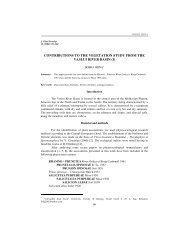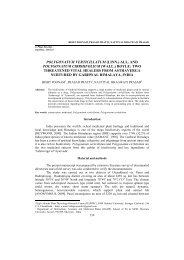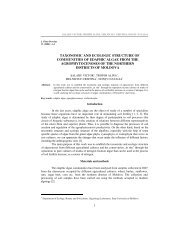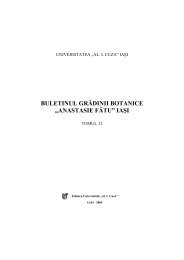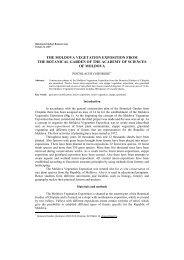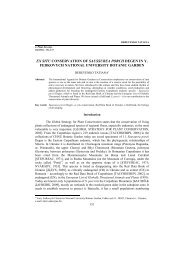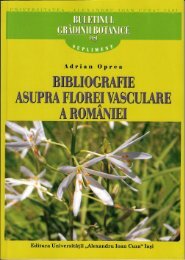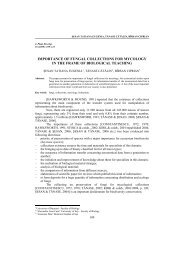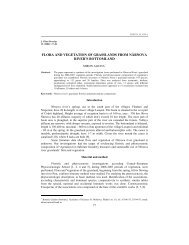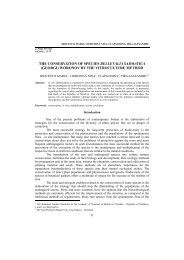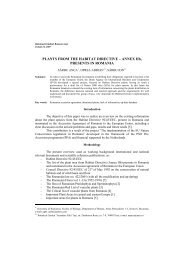comparative study on the field performance of fhia-01 (hybrid ...
comparative study on the field performance of fhia-01 (hybrid ...
comparative study on the field performance of fhia-01 (hybrid ...
Create successful ePaper yourself
Turn your PDF publications into a flip-book with our unique Google optimized e-Paper software.
COMPARATIVE STUDY ON THE FIELD PERFORMANCE OF FHIA-<strong>01</strong> (HYBRID DESSERT…<br />
The faster growth <strong>of</strong> in vitro-propagated plants could be attributed to <strong>the</strong>ir intact<br />
active roots and shoot systems that can functi<strong>on</strong> almost immediately after planting. Unlike<br />
in <strong>the</strong> c<strong>on</strong>venti<strong>on</strong>al method where paring is d<strong>on</strong>e <strong>on</strong> <strong>the</strong> sucker before planting <strong>the</strong> in vitropropagated<br />
plants c<strong>on</strong>tinue to photosyn<strong>the</strong>size immediately after planting. There is<br />
<strong>the</strong>refore a lag phase in <strong>the</strong> sucker-derived plants. This lag phase may take two weeks or<br />
more for <strong>the</strong> sucker to recover. Also <strong>the</strong> in vitro-propagated plants might have some carryover<br />
nutrient stock up<strong>on</strong> which <strong>the</strong>y could depend. The factors described above could<br />
explain <strong>the</strong> differences observed between <strong>the</strong> in vitro-propagated and <strong>the</strong> sucker-derived<br />
plants.<br />
C<strong>on</strong>clusi<strong>on</strong><br />
The <str<strong>on</strong>g>study</str<strong>on</strong>g> has revealed that tissue culture applicati<strong>on</strong> in banana planting material<br />
producti<strong>on</strong> c<strong>on</strong>tributes significantly to crop <strong>performance</strong>. Tissue culture produced plantlets<br />
become robust in <strong>the</strong> <strong>field</strong>. It could be c<strong>on</strong>cluded that tissue culture produced planting<br />
materials perform agr<strong>on</strong>omically better than c<strong>on</strong>venti<strong>on</strong>ally produced materials.<br />
References<br />
1. BAKER S. 1959. Bananas in East Africa. Emp. J. Exp. Agric. 20: 66-76.<br />
2. DREW R. A. & SMITH M. K. 1990. Field evaluati<strong>on</strong> <strong>of</strong> tissue culture banana in South-Eastern Queensland.<br />
Aust. J. Exp. Agric. 30: 569-574.<br />
3. DIRK R. V. & ORTIZ R. 1996. Field <strong>performance</strong> <strong>of</strong> c<strong>on</strong>venti<strong>on</strong>al versus in vitro propagules <strong>of</strong> plantain<br />
(Musa spp.) AAB group. HortScience. 31(5): 862-865.<br />
4. FAO (Food and Agriculture Organizati<strong>on</strong> <strong>of</strong> <strong>the</strong> United Nati<strong>on</strong>s). 1995. FAO Yearbook <strong>of</strong> Agriculture.<br />
Rome. Italy.<br />
5. FRISON E. A., COLLINS W. W. & SHARROCK S. L. 1997. Global Programs: A new visi<strong>on</strong> in Agricultural<br />
Research. Issues in Agriculture. 12: 29 pp.<br />
6. INIBAP. 1993. Biotechnology applicati<strong>on</strong>s for banana and plantain improvement. Proceedings. Workshop.,<br />
San Jose, Costa Rica, 27-31 Jan.1992. Internati<strong>on</strong>al. Network for <strong>the</strong> Improvement <strong>of</strong> Banana and<br />
Plantain (INIBAP), M<strong>on</strong>tpellier, France.<br />
7. LARKIN P. J. & SCOWCROFT W. R. 1981. Somacl<strong>on</strong>al variati<strong>on</strong>-A novel source <strong>of</strong> variability from cell<br />
culture for plant improvrment. Theor. Appl. genet. 58: 197-214.<br />
8. PERSLEY G. J. & DE LANGHE E. A. (ed). 1987. Banana and plantain breeding strategies. Proc. Intl.<br />
Wkshp., Cairns, Austral., 13-17 Oct. 1986. ACIAR Proc. No. 21. Austral. Cent. Intl. Agr. Res., Canberra.<br />
9. ROBINSON J. C. & ANDERSON T. 1991. Repeat trials c<strong>on</strong>firm advantages <strong>of</strong> banana tissue culture in plant<br />
crop. Itrus Subtrop. Fruit Res. Inst. Inf. Bull. 288: 10-11.<br />
10. ROBINSON J. C., CONNIE F. & ECKSTEIN K. 1993. A <strong>field</strong> comparis<strong>on</strong> <strong>of</strong> c<strong>on</strong>venti<strong>on</strong>al suckers with<br />
tissue culture planting over three crop cycles. J. Hort. Sci. 68: 831-836.<br />
11. SAMSON J. A. 1986. Tropical Fruits. Sec<strong>on</strong>d editi<strong>on</strong>. L<strong>on</strong>gman, New York.<br />
12. TRIBE D. 1994. Feeding and Greening <strong>the</strong> World: The Role <strong>of</strong> Internati<strong>on</strong>al Agricultural Research. Ox<strong>on</strong>,<br />
United Kingdom: CAB Internati<strong>on</strong>al.<br />
13. VUYLSTEKE D., SWENNEN R. & DE LANGHE E. 1991. Somacl<strong>on</strong>al variati<strong>on</strong> in plantains (Musa spp.,<br />
AAB group) derived from shoot-tip culture. Fruits. 46: 429-439.<br />
14. VUYLSTEKE D., SWENNEN R. & ORTIZ R. 1993. Development and <strong>performance</strong> <strong>of</strong> black sigatokaresistant<br />
tetraploid <strong>hybrid</strong>s <strong>of</strong> plantain (Musa spp., ABB group). Euphytica. 65: 33-42.<br />
15. SMITH M.K. 1988. A review <strong>of</strong> factors influencing <strong>the</strong> genetic stability <strong>of</strong> micro-propagated bananas. Fruits.<br />
43: 219-223.<br />
16. ZAMORA A. B., DAMASCO O. P., ESTANO E. S., BARBA R. C. & PATENA L. F. 1989. Growth and<br />
yield <strong>of</strong> in vitro and sucker-derived banana plants (Musa spp.) cvs. Lakatan, Bungulan and Saba.<br />
Philippine Agriculturist. 72: 458-465.<br />
46



